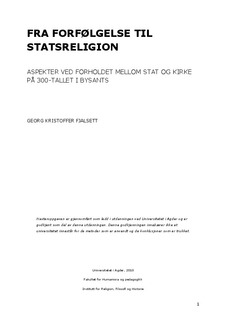Fra forfølgelse til statsreligion : aspekter ved forholdet mellom stat og kirke på 300 tallet i Bysants
Abstract
This theses deals with the relation of state and church in 4th century Byzantium. The research has been conducted based on three individual sources, namely the works of Eusebius of Cæsarea, Codex Theodosianus and church buildings. the main question has been: How did relations between church and state develop in 4th century Byzantium, and how did this development affect the power and identity of the church? The relations between church and state were strengthened by the fact that they were dependent of each other. The state needed the church to create unity in the multiethnic Byzantine empire. The church needed the state promote the new religion in a best possible way. In that process, the church was organized and became a main political organization. Eusebius founding of the political theology is used as a means to explain the success of church and state in the 4th century. I have analyzed the sources searching for an answer to whether they provide enough proof to claim the existence of an overall propaganda program. If such a program did exist, my hypothesis is that it would be evident in these sources. In that I ask whether the making and presenting of propaganda may be a means to try to explain the rapid spread of Christianity in The Roman Empire from the time of Constantine 1 until the death of Theodosius 1. the method used has been to let these three indivvidual sources illuminate a conjuct main question. This thesis concludes that most actions taken, including legislation, the building of churches, the development and use of liturgy, symbols and art as well as the writings of Eusebius were politically motivated and promoted the political theology.
Description
Masteroppgave i historie- Universitetet i Agder 2010
